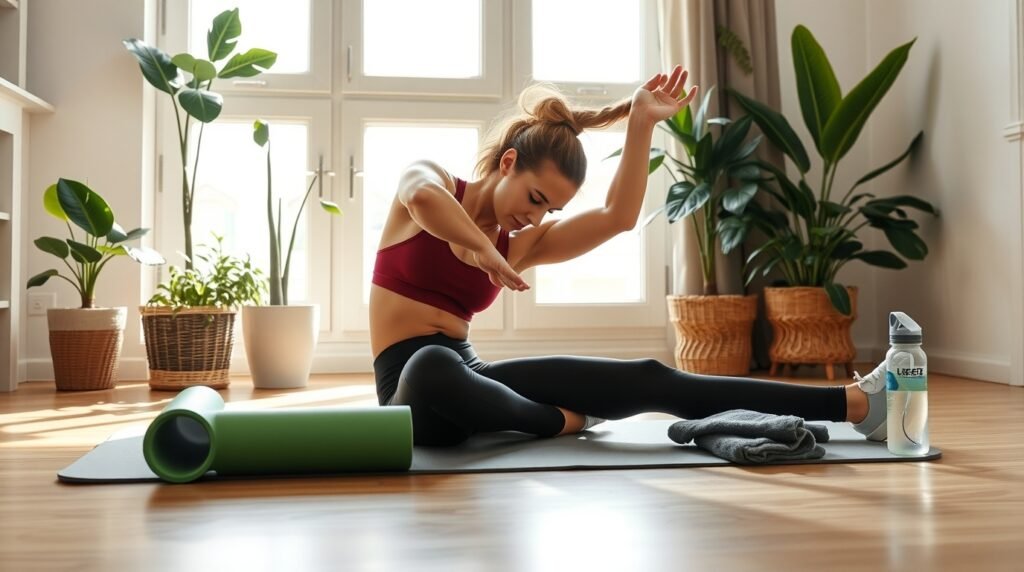
How to Burn 1000 Calories a Day and Do These Methods Work?
Burning 1000 calories in a day may seem impossible, but it can be done and shouldn’t take all your time. Here’s a deep dive into some of the ways you can reach this caloric deficit with as much healthy living as possible.
High-Intensity Interval Training (HIIT)
HIIT is a great way to burn calories fast. It consists of short intervals of intense exercise followed by brief rest periods. For instance, 30 seconds of sprinting alternating with a minute of walking can burn calories in a fraction of the time it takes steady-state exercise. Here are some HIIT options:
- Interval running or cycling
- Bodyweight workouts such as burpees and jump squats
- Circuit training with weights
30 minutes of HIIT can typically burn around 400-600 calories, depending on the intensity and your body weight.
Strength Training
Another incredible way to rev your calorie burn – even at rest – is through resistance training that builds lean muscle. Muscle added means a higher basal metabolic rate (BMR), and a higher BMR means you will burn more calories over the course of each day. Effective strength training strategies include:
- Free weight or machine resistance training
- Resistance band workouts
- Push-ups and squats Here we go with the bodyweight exercises again!
One hour of strength training burns anywhere between 300-500 calories if you’re going at an intense pace.
Cardio Exercises
You build your stamina with cardio, and you also burn a ton of calories doing so. Here are some popular options:
- Running: Depending upon your pace and weight, you can torch 600-1,000 calories an hour.
- Cycling: A fast-paced ride can torch 500 to 900 calories an hour.
- Swimming A vigorous hour of swimming can burn about 500-700 calories.
A mix of these cardio exercises for 1-2 hours will help you to attain your daily calorie burning objective.
Daily Activities and Lifestyle Modifications
There is more activity to add to into your everyday and burn calories. Here are several tactics that can help:
- Opting for the stairs in place of elevators
- Walking or riding for errands close to home
- Household tasks such as cleaning, gardening
Even short acts can add up; 10 minutes of walking will consume about 50 calories. If you incorporate these practices into your day, they can also help you narrow the gap on that 1000-calorie goal.
Proper Nutrition and Hydration
The key to a high-caloric bank is eating a good, balanced and nutrient-dense diet. Here are some important points:
- Consume adequate lean protein, which boosts muscle development.
- Drink more water: It may help you burn more calories.
- Load up with fruits, vegetables and whole grains; you’ll keep yourself fueled throughout the day.
Combining an exercise program with good nutritional choices also guarantees you have the energy necessary to get through high calorie burning activities.
Consistency and Rest
Whatever is done, however well, will have to be repeated. Try to exercise most days of the week. And also that recovery and rest is key with any fitness regimen. Make sure to include:
- Days off to keep from burning out and getting hurt.
- Good sleep to aid muscle recovery and balance hormones.
You will be able to work harder and at a higher intensity both technically in the gym, as well as outside of it by allowing your body adequate recovery time.
By incorporating these efficient tips into your day, burning 1000 calories in a day is not only possible but an exhilarating goal as well. Whether it’s going to the gym, making minor changes in your life or doing both, you’re getting somewhere even if it seems like a battle!
High intensity interval training and calorie burning

High-Intensity Interval Training, better known as HIIT, has become a household name in the fitness industry and for good reason. This training system maximizes calorie burning to achieve fitness goals faster. If you are seeking a proven way to lose weight, keep it off or even maintain your current weight, the science behind HIIT will provide the answers you’re looking for.
What is High-Intensity Interval Training?
In HIIT, participants engage in brief bouts of very high intensity activity interspersed with short recovery periods. For instance, you could sprint for 30 seconds and then walk or run for another 30. You start and stop this cycle a number of times making quite an intense workout that works your chest hard, boosts your metabolism and taxes your cardiovascular in order to lose man boobs.
Why HIIT Burns More Calories
The secret behind HIIT is that it raises the heart rate to a higher extent than most other workouts. If your heart rate authority surges, you burn calories not just while working out but after as well. This is referred to as the “afterburn effect” or EPOC (excess post-exercise oxygen consumption). Your body will keep burning calories at an accelerated pace following the workout.
Pros and Cons of HIIT for Caloric Burn
- Time Conducive: You can get a full workout in just about 20-30 minutes due to which you can eliminate your traditional workouts which ate up 1 hour of your time or more.
- Variety: HIIT can include a variety of exercises, from running and cycling to strength training. This keeps your workouts engaging.
- Builds Muscle: HIIT may incorporate some strength training moves into the workout which will help you become more lean and toned, however you are left with a higher resting metabolic rate.
- Improves Cardiorespiratory Health: HITT sessions over time will help you keep your heart healthy and develop a good aerobic capacity, providing better endurance to everyday physical activities.
- Burns Fat: Research has demonstrated that HIIT promotes significant reductions in abdominal fat, the type of fat someone who wants to be fit, rather than skinny, needs to get rid of for long-term health.
Getting Started with HIIT
If you’re not used to the workout, it’s best to take your time. Here’s an easy guide to make sure you can incorporate this type of training into your regimen safely:
- Seek Professional Advice: If you have any medical condition seek medical advice prior to participating in physical exercise.
- Pick Your Exercises:Select exercises that are fun and kept at a high intensity. Sprint or go for a ride, do some body-weight exercises or hit the weights.
- Warm-Up: Always warm up for 5-10 minutes to avoid potential injury. Dynamic stretches and some light cardio can be good choices.
- *Design Your Workout: Perform a 20-30 second burst of high-intensity effort and rest for 30-60 seconds. Repeat for 15-20 minutes.
- Cool Down: Spend 5-10 minutes cooling down and stretching after you’ve date-ed. This helps with recovery.
Types of HIIT Workouts
Below are some types of HIIT workouts you might incorporate into your fitness regimen:
- Tabata: A type of HIIT that includes 20 seconds work, followed by 10 seconds rest (repeated for minutes four times).
- Circuit Training : Alternates between strength-based and aerobic exercises to provide a full-body workout.
- Sprint Intervals: Brief, all-out work followed by periods of recovery and repetition that can add speed and endurance to the mix.
Tracking Your Progress
Keep a workout journal to monitor how well your HIIT sessions are working. Write down your exercises, how long you did them and your calorie estimates. Some fitness trackers can even help you keep track of your heart rate and the number of calories burned between those sessions.
Don’t forget that while HIIT is great for burning calories, the benefits of this form of workout are even more enhanced when combined with a good diet and other types of exercise. Always pay attention to what your body is telling you and make the most of the process while you’re building your strength!
With the right mindset and commitment, high-intensity interval training can give you double the results in less time while keeping your workouts fresh and entertaining.
A 1000-Calorie Deficit by Nutrition?

When your goal is to burn 1,000 calories a day, nutrition becomes an integral piece of the puzzle. The foods you consume should work for you — not against. This relationship is very important in crafting your 1,000 calorie deficit. Here’s a guide to help you find your way through the nutritious options that can help you reach your goal.
Understanding Your Caloric Needs
Before we get into the nitty-gritty of which foods contain more or fewer calories, it’s important to understand how your body uses those calories. Everyone has different calorie requirements based on the factors of age, gender, weight and activity level. You need to burn 1,000 more calories than you eat every day to have a 1,000-calorie deficit. Calculate your Total Daily Energy Expenditure (TDEE) using an online calculator for optimal results. This will provide you with something to build on.
Types of Foods to Include
To still have a nutritionally sound diet, make the conscious effort to include healthy food types that are high in nutrients. Here are some categories and examples to consider consuming:
Lean Proteins
- Chicken breast
- Turkeys
- Fish (salmon, tuna)
- Legumes (beans, lentils)
- Greek yogurt
The proteins not only help in muscle recovery, but also fill you up for longer. In that way you don’t overeat and keep your caloric difference.
Whole Grains
- Quinoa
- Brown rice
- Oats
- Whole grain bread
- Barley
Whole grains are full of fiber, which can help keep you regular and feeling full. A high-fiber diet can also help control your hunger by maintaining steady blood sugar levels.
Fruits and Vegetables
- Spinach
- Kale
- Broccoli
- Blueberries
- Apples
These food items are low in calories yet high in bulk, so they make for the best options for a calorie deficit. And they deliver important vitamins and minerals that ensure you are not losing weight at the expense of good nutrition.
Timing and Frequency of Meals
The timing of your meal can also have an impact on the success. Eating little and often can help you to avoid feeling deprived. Shoot for five or six mini-meals a day. This slow and steady method will help you keep your energy up — and metabolism churning.
Caloric Beverages to Avoid
And be careful what you drink. Beverages can add a lot of calories without adding bulk and satiety. Consider minimizing or avoiding:
- Sodas
- Alcoholic drinks
- High-calorie coffee drinks
- Fruit juices (choose whole fruits instead)
Sticking to water, herbal teas or black coffee can end up saving you calories and keep you hydrated.
Mindful Eating Practices
Crucial to achieving a 1,000 calorie deficit is mindful eating. Listen to your hunger signals and eat slowly. This gives your brain the chance to pick up on any signals coming from your stomach and determine if you’re full so you don’t overeat. Pile your plate with vibrant foods, ones that can make healthy eating seem more fun.
Strategies to Stay on Track
To help you remember to focus on nutrition:
- Pre-planning your meals and snacks.
- A food log can be a good way to record your intake.
- Set achievable daily calorie goals.
- Exercise regularly in addition to your diet.
Keep in mind this isn’t a race to drop 1,000 calories. Instead, try to develop habits that you can sustain in the long run.
Proper nutrition will support your goal of burning 1,000 calories a day. And by being aware of what you are eating, and learning to eat raspberries in moderation, and all else in the same manner – you will be right on your way to being able to lead a balanced lifestyle.
Outdoor Activities That Burn 1000 Calories: Discover Options

It’s no secret that people are always looking for ways to torch calories in the great outdoors. By getting out of the house and being active you can accomplish your calorie count, all while taking a break from everyday life. So what are the outdoor alternatives that you can consider to burn 1000 calories a day? Here are six fun activities that can get your heart racing and your calories burning.
Hiking
Hiking’s a great way to be one with nature and also get in shape. A vigorous hike can burn around 430 to 550 calories an hour, depending on factors such as the weight of your pack and the incline. Looking to reach that 1000-calorie goal, a difficult hike lasting two or three hours is ideal.
Cycling
Biking would be another fun outdoor activity. If you like it on dry roads or downhill in the woods, road (400-700 calories per hour) and mountain biking (500 – 1000 cals/h) are among some of the best ways to burn all under-the-sun-named annoying little fat cells! For example, highly energetic mountain biking can be beneficial in achieving your goals fast.
Running or Jogging
Leisurely running or jogging in the open air is a tried and tested one. And for a 160 pounder, one hour of running at a five mph pace burns about 600 calories. If you’re more advanced, add in sprints at six miles per hour to make that number soar. You will need to do 7 (his or her) four mile run/hikes to hit the magic 1000 calories by which time you’d think dinner would be ready, even if it means it’s just beer and pretzels on a tray.
Swimming
Taking a dip in an outdoor pool or natural body of water offers both fun and fitness. Depending on your stroke and intensity, you can burn anywhere between 400 and 500 calories an hour. Going for a swim can be an invigorating way to reach your 1000-calorie target.
Kayaking or Canoeing
Canoeing and kayaking Get a serious workout while exploring the rivers or lakes near you. paddling with vigor can torch between 400 and 500 calories an hour. Push that over 1000 and you can be happy with a two to three hour outing.
Rock Climbing
If you are out for some adventure rock climbing is one. Depending on the difficulty of your climbing, and your own body weight, it burns may 400 to 800 calories an hour. Depending on the type of trail and your skill, you may want to go for a good two-hour session in order to burn some calories effectively.
Group Sports
Play group sports such as soccer or ultimate frisbee. According to Dr. Herrman, such activities can burn between 500 and 800 calories an hour. Play a game for an hour or two soon and you can hit your goal fast, while also enjoying some camaraderie with your buddies.
Cross-Country Skiing
For those who live in colder climates, cross-country skiing can be a challenging workout. Depending on speed and effort, you can burn 400 to 600 calories an hour. If you want to surpass your 1000-calorie target, a short two-hour skiing session is all it takes.
Backpacking
Backpacking is a combination of hiking and camping that gives you an all-over body workout. And you’ll burn an extra 500 to 700 calories per hour, thanks to the added resistance from your heavy backpack. A full day of hiking with gear could easily have you top the 1000-calorie mark.
Keep your calorie-burning sessions fun by mixing and matching these activities. You can go hiking in the morning and swimming in the afternoon or cycling with friends on weekends. Just keep in mind the principles of intensity and duration that are required to burn 1000 calories a day.
As always be sure you’re properly hydrated and keep your goals in perspective according to your level of fitness. Ease your way into it; start at a low intensity and slowly build up until you feel like you can keep going forever. As you explore outdoor calorie burners, here are a few activities that could help you find the love of your life, maybe.
Have fun! This is not to say that Wolf wound up enjoying exercise, but repeat doing it makes it easier to stick with the fitness in general. So strap on your gear, burst out of your cocoon and start torching those calories!
Support the cardiovascular and strength benefits with a blend of cardio exercise and strength training.

When we’re talking about general fitness and burning calories, balance is key; you always want to make sure you’ve got some cardio and some strength in your program. All forms of exercise have their respective advantages, and they all work together to burn calories effectively while enhancing fitness. Read on for how best to combine these two elements to achieve the most success.
Understanding Cardio and Its Benefits
“Cardio” exercises work on increasing your heart rate. For this you need to exercise and that doesn’t have bean bags under any circumstances. These type of activities require some good old fashioned exercise…running, cycling, swimming or even fast walking! Here are a few key benefits:
- Burns Calories Effectively: Aerobic exercises are great at burning calories fast to help you lose weight.
- Enhances Stamina: Doing frequent cardio can make you stronger and help to maximize energy for day-to-day activities.
- Good for Heart and Lungs: It works on the heart’s endurance, further reducing risk of heart disease.
The Role of Strength Training
Cardio is great for calorie burning in the short term, but strength training develops muscle mass — which can work to up your metabolism in the long run. Here are a few reasons to add strength exercises:
- This muscle gain increases your resting metabolic rate which means you then burn more calories every second even whilst at rest.
- Improves Functional Strength: Resistance training helps to maintain and even increase muscle strength, so that lifting a bag of groceries is no longer a feat.
- Promotes Bone Health: Weight lifting is beneficial for increasing bone density and helps prevent osteoporosis.
Finding the Right Balance
To maximize calorie burn you need a combination of cardio and strength training. Consider these strategies:
- Weekly Schedule: Shoot to get in at least 150 minutes of moderate-intensity cardio (or 75 minutes of high-impact cardio) each week, as well as strength training twice a week.
- Mix Workouts On the days you do strength workouts, add some cardio — as a warm-up or cool-down. This may include light jogging, cycling will be helpful to relax or activate your muscles.
- Types of workouts: Mix in some cardio and strength training to avoid boredom and work all of your muscle groups.
Sample Workout Structure
Here’s an example of what a week of balanced work outs might look like:
- Monday 30 minutes running + 30 minutes upper body strength training
- Tuesday: 45 minutes of cycling
- Wednesday: 30 minutes swimming + 30 minutes leg strength work.
- Thursday: Rest day, stretching, or yoga.
- Friday: 30 minutes of running + 30 minutes of full-body strength training
- Saturday: Go for a 60-minute hike or do some brisk walking
- Sunday: Rest day
Listening to Your Body
Listen to your body as you do so while keeping this equilibrium in mind. Recovery is crucial. Going overboard can lead to injury and can slow down your progress. Make sure your muscles are getting their rest, especially after those heavy lifting days. This is not only going to help prevent injuries, but it’s also going to increase your performance in the long run.
Nutrition Matters
There’s more to fitness than just a good workout. What you eat is critically important in terms of energy, recovery and overall performance. Eat a diet high in whole foods, protein, healthy fats and carbs to support your workouts. Hydration is also key for keeping energy levels up and performance high in both cardio and strength workouts.
When it comes to maximum calorie burn, it’s not just about the cardio — it’s about a careful mixture of cardio and strength training. When you listen to your body and achieve the perfect balance, you’ll reap the benefits of an effective fitness routine. So tie your shoes, pick up the weights and get ready to embark on a path toward a healthier, fitter you!
Conclusion
It is entirely possible to burn 1000 calories a day; however it comes down to planning, organization and an understanding of how energy balance works. By testing out different ways that work like for example adding HIIT, you can even multiply your calorie-burning power. High intensity interval training (HIIT) not only makes the most of your workout time but also causes your body to raise you metabolism for hours after you have completed your workout.
Diet is important in creating a caloric deficit of 1000. select the foods and Portions that will help you process in running While meeting your goals. Knowing how the various nutrients affect metabolism is critical to designing a balanced diet that will help you achieve your fitness goals.
Enjoying the great outdoors is also a fun, calorie-burning way to be active. Whether its a walk, a bike ride or even playing sports these options give you the opportunity to act in nature as you work towards burning those calories. Adding purpose to outdoor activities can be particularly rewarding.
The key is not to tilt too far in the direction of one or the other. Cardio workouts burn calories while you’re doing them, and strength training builds muscle, which in turn increases your resting metabolism. The incorporation of these types of training enables a more complete calorie burn.
If you practice these ideas, and consider the balance of your life over all, not only will you be able to try to burn 1000 calories a day but live in a well maintained condition. Don’t forget – the key is being consistent, once you find something that works for you it’s just a matter of time to reach your goals!
1 thought on “How to burn 1000 calories a day? Complete Guide 2025”